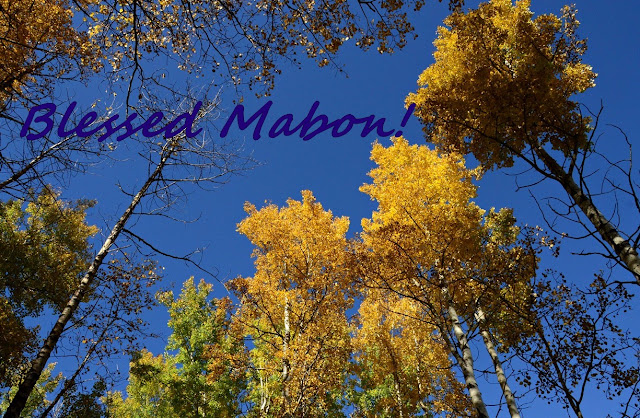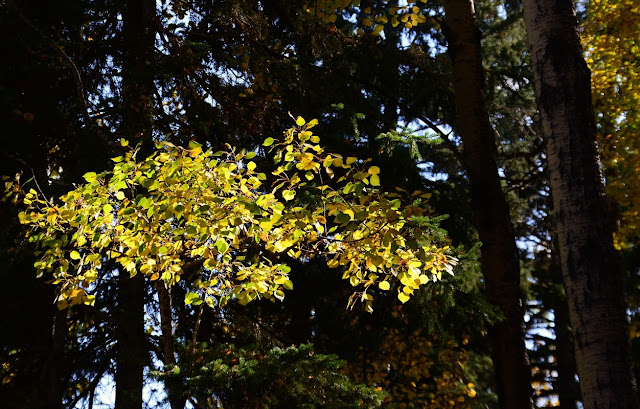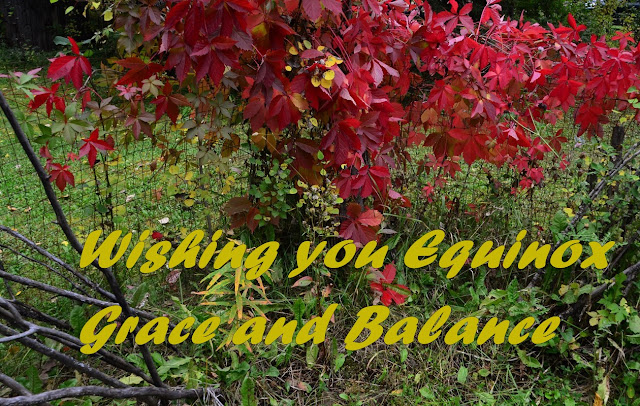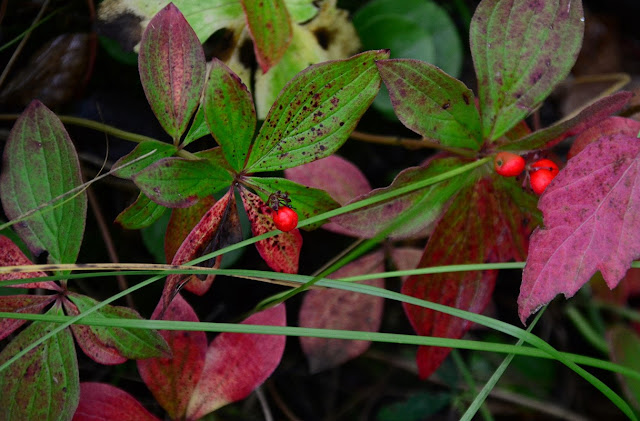I've become more and more interested in ancient
traditions that mark and celebrate the changing and passing of the seasons.
Growing up on a farm, seasons and weather were very important to daily life,
but as a child, I had no part in decision making and just took each day as it
came (not a bad attitude!). Then, years of city living with no outdoor soil
under my stewardship meant seasons and weather were mostly about convenience.
Since 2007, living in the country again, the yearly cycles and weather variations
have been much more relevant. As I garden and tend to land in various states of
wildness, water or lack of it, frost, snow cover and more, matter. As going
anywhere involves a significant drive, weather and road conditions are a
regular consideration. As I paint and write and photograph, themes that revolve
around the 'natural' world, cycles and patterns of climate and weather, and how
we relate to the world practically and symbolically are ever more top of mind.
I've also always been interested in those levels of
experience and reality that go beyond
prosaic, physical life- deep and transcendent levels of spirit, mind or
emotion, intense moments of human experience or of awe and insight which wrench
(or nudge) us into greater awareness of existence beyond our limited, practical
daily view.
The history (and pre-history) of art, culture, social
organisation, religion (basically, cultural anthropology!) has always been
another area of focus for me, first simply because it is interesting to learn,
second because as an artist, there are often themes and styles that are
appealing, and third because in the effort to grow and fully develop as a
person, it is useful to see how other peoples in other times have approached
the issues of being. Of course it is unwise to romanticise other times, other
peoples: they were human, and subject to the same failings as us. However,
there have been, and are, cultures (societal or personal) with lessons for us:
lessons on how to be more attuned to the world around us, vs insistent on
overriding every natural phenomenon with technology; how to see ourselves as
part of a greater whole rather than a stubbornly isolated individual; how to
restore awe and wonder to our daily lives instead of relegating that joy to
childhood, and adulthood to a world of mechanistic routine.
For me (setting aside a discussion of comparative
religion, and all the history and politics inherent!) the confluence of all
these things (along with some interest in family roots) has led me to explore
pre-Christian beliefs and practices (the word pagan is typically used, and I
will use it at times, in line with modern usage of the term, but it has some
drawbacks, that's another subject!). Since my mother's family was Latvian, and
since that country has a relatively well preserved cultural history, I've focussed
on that (Baltic in general), but putative ancient Goddess cultures throughout
the Old World, and practices in Celtic and Nordic countries are of course
related, and relevant to other bits of my heritage, as well as some outlooks of
indigenous North American peoples (which I had thought to be part of my
heritage- the list of topics for other days stacks up!). While the polytheistic
religions that immediately preceded Christianity have left some interesting traditions,
useful sets of symbolic names, and at times reflect older roots, my real
interest goes even deeper, earlier, to the animistic or 'shamanic' (another
troublesome word, for another day?) cultures.
These ancient peoples (and some indigenous cultures
today) generally did/do not have extensive technology to separate them from
'nature', so they did not think of themselves as apart from animals, trees,
water-the earth!- in the way our modern cultures, based on control and
dominance, have done. All the non-human lives around were 'people', and had
spirits and personalities, as did rocks, rivers, mountains, clouds. You might
dismiss this as anthropomorphism, but you'd be missing the point: by assigning
life, soul, personhood, we assign value. We do not own the world around us, we
are part of it, we collaborate and struggle, nurture, compromise, guide and are
guided. In societies that long ago moved
to agriculture, in whole or in part, the relationship to the 'wild' world
beyond the farm and village would have shifted, in some cases from partnership
to fear. Still, an intimate relationship with the seasonal cycles would have
been just as crucial to survival, and certainly northern societies (at least in
more rural populations, a majority in most countries until recently) retained a
connection to the great forests that surrounded them, and which still supplied
many material needs.
All this to say I've been looking into some of the
ancient and traditional customs of the Balts and other northern peoples in recent
years, especially around equinox and solstice times, those symbolic and
practical dividers of time and season through the year.
Currently, I wanted to do something for the Autumn
Equinox. Autumn /Fall has several definitions: astronomical (position of
sun/earth-equinox), meteorological (weather! based on groups of 3 months, the
start date of September 01 is a realistic start of the season here) and simple
social, cultural references based on how it 'feels' (pumpkin spice latte
season?). While our fall colour and potential for frost and snow starts well
before the equinox, the date near the end of September does provide a useful
marker and reminder to be finishing vital tasks before the onset of cold
weather and an emotional, spiritual reminder to shift to the cold season
turning inward- a time for reflection, stock-taking, meditating on balance
(equal day and night), giving space to inevitable decay and death- and the
renewal that follows! Of course we can't forget the importance of harvest and
gratitude for the gifts of the season of growth.
With no chance to plant a vegetable garden this year,
my harvest has been limited to seeds and some fruits and berries, eaten while
working outdoors! but the bounty of
summer, glory of the transition, and preparation for the cold time to come are
all meaningful, and the sense of transition/loss is amplified for me by the
first anniversary of my mother's death. So, here we go, a little altar/offering I prepared yesterday,
with both the equinox and my mother in mind..
What follows are some of the bases for my offering,
which in the end was specifically relevant to me, my mother and this time and
place...
It seems the Baltic /Latvian traditions have become a
little muddled over the centuries, due to the interference of the Christians,
and influences from more southerly cultures (but that is a living culture, not
a museum display). First we have Maras day, which is a harvest festival devoted
to the Great Mother (presumably a connection to earlier Goddess centred cultures)--
it has been bumped to August 15, to be midpoint between mid-summer and
Michaelmas. Then, Apjumibas, in honour of Jumis, 'twin' god of fertility,
grains, the ox (this must tie back to horned gods, and the antlered gods before
them) also protector of forest riches, pertinent to me. Originally celebrated around
the Autumn Equinox, this has been largely pushed toward the end of the month
for Mikeli or Michaelmas, but is still a harvest festival, and the beginning of
the days of the dead (when the generally benign spirits of the dead walk the
earth, and are welcomed home for a
feast, among other customs).
For my offering/ altar, I chose a spot between a couple
of (unused this year) vegetable beds to maintain the harvest and land
stewardship connection (it was felt that if Jumis was not appropriately
honoured, the following year would have a poor harvest-- this reverence for the
land will of course also ensure proper practical measures), with a colourful
backdrop of autumn coloured Parthenocissus/ Virginia Creeper; I pulled some of
the weeds, laid a ground of mostly dried grasses and branches of poplar and
wild rose with fall colour. Next a flattish sandstone rock was laid for the
altar, and decorated with coloured leaves and some late garden flowers, symbolising
both summer's bounty and the harvest of seed; I included several stems of
silver/white leafed Cerastium 'Snow in Summer' and Lamium to symbolise winter
to come, snow, bone, death. Then I chose several stems of apples, in honour of
harvest, in twos as a nod to Jumis, the twin, and a sheaf of native grass to
represent grains. Finally a candle, for the layered symbolism of fire (sacred
to ancient Balts), of sacrifice, and the traditional gift of wax to Jumis.
Above all, the preparation and laying of the offering
was a mental and emotional-spiritual exercise, not an attempt to influence the
external world, but a way of acknowledging it, of bringing myself into harmony
with it, and time spent thinking of the land around me and all it bears, and of
my mother.
I hope you enjoyed, and hope you took a moment this
year to reflect on the meaning of the equinox, enjoy the season at hand,
prepare your mind and heart for the days to come!







One word................BEAUTIFUL
ReplyDeleteCohan, your connection with nature and the love for it inspires many.
Today, society has finally woken up to a rebirth, to protect our planet. Your postings are amazing ! Best Regards, Steve
Thank-you! It's good to know it reaches someone :)
Delete